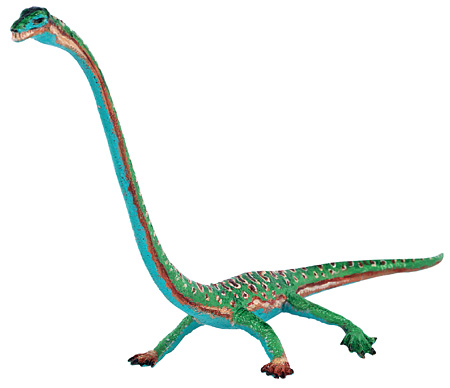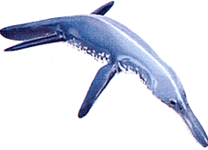
Paleozoic and Mesozoic Seas
Paleozoic Diorama More Diorama
from the Dinosaur Collector update 121110
 Cambrian Explosion, The
seas burst into life.
Cambrian Explosion, The
seas burst into life. Ordovician, the golden age of trilobites.
Ordovician, the golden age of trilobites. Silurian, age of fish
Silurian, age of fish Devonian the placoderms.
Devonian the placoderms.at the end of the Permian there was a major change in the worlds oceans. The last of the trilobites had become extinct, brachiopods are now a found primarily in extreme environments like cold water and caves. Reef building stops and the corals from from the Paleozoic become extinct. By the Middle Triassic the dominate Paleozoic Seas fauna were either extinct or only existed as a few species. The modern sea fauna largely evolves replacing the community of stationary filter feeders characteristic of the Paleozoic to one dominated by active swimmers. Diaspid reptiles have often returned to sea, the latest being the Marine Iguana. Their side to side walking motion on land converts easily an efficient fish like motion for life in the water. The Mesozoic starts in the Triassic and ends with Cretaceous. Not everything big and dead is a dinosaur.
Mesozoic Seas
Dino Boyz Sam and Taliesin with the Under Sea action set.
Use the Links to find the Diorama you are interested in.
Sea Life Diorama
Prehistoric Marine figures have never been common. The MARX company produced a Kronosaurus that was copied by MPC and other toy companies. The figure was pretty inaccurate even for the 60's. The SRG metal figures that were sold in Museum gift shops produce a Mosasaur and a Dunkleosteus figure. Some small headed long necked plesiosaurs and nothosaurs were also produced by minor toy makers. The Starlux, Invicta , Schleich, Bullyland, CollectA, Kinto and Safari companies included prehistoric sea creatures in their lines. In the last few years Procon, Kaiyodo Dino Tales and Yowies series have produced an explosion no only in number of figures but in the species represented. The Walking with Dinosaurs Documentary made the pliosaur Liopleurodon a house hold name and a popular figure.
The Triassic
Seas were initially
populated by the survivors of the Permian extinction, the first ichthyosaurs,
Grippia and Utatsusaurus
are found in the Early Triassic. Placodonts and nothosaurs appear in the
fossil record in the Early Triassic. By the Middle Triassic reefs were
once more being built, Tanystropheus  is
established as an aquatic predator and the new seas fauna began
to take on a modern character . The Nothosaurs relatives the
Plesiosaurs develop in the Late
Triassic.
is
established as an aquatic predator and the new seas fauna began
to take on a modern character . The Nothosaurs relatives the
Plesiosaurs develop in the Late
Triassic.
In the Early
Jurassic, Pangaea breaks up and the sea expands to cover many
Triassic Deserts. The flowering of the ichthyosaurs  and
plesiosaurs.
and
plesiosaurs.
The Late
Jurassic Seas see two major groups of plesiosaurs. The long
necked small headed plesiosaurs  ate smaller sea creatures. The pliosaurs
ate smaller sea creatures. The pliosaurs  get really big the size of modern whales. Modern fish (telosts), sharks
and ammonites populate the sea. Several members of the crocodile family
go to sea and the first family of turtles goes to sea.
get really big the size of modern whales. Modern fish (telosts), sharks
and ammonites populate the sea. Several members of the crocodile family
go to sea and the first family of turtles goes to sea.
Early
Cretaceous seas are dominated by the famous pliosaur Kronosaurus ![]() .
Giant squids and ammonites are common. modern Sharks and boney fish are
evolving into new types. Ichthyosaurs are decline suddenly and there
may have been changes in the ocean circulation that made the depths
oxgen deprived. The long necked Jurassic plesiosaurs die out and are
replaced by elasomsaurs thought to be descended from pliosaurs. The
early mosasaurs appear.
.
Giant squids and ammonites are common. modern Sharks and boney fish are
evolving into new types. Ichthyosaurs are decline suddenly and there
may have been changes in the ocean circulation that made the depths
oxgen deprived. The long necked Jurassic plesiosaurs die out and are
replaced by elasomsaurs thought to be descended from pliosaurs. The
early mosasaurs appear.
In the Late
Cretaceous Seas new reptiles take to the seas. Shallow seas spread over
many of the continents. Some birds will give up flight to become dedicated
swimmers.
The mosasaurs ![]() relatives of today's monitor lizards go to sea as do some crocodiles.
They get big and mosasaurs give birth to snakes who may be the only descendants
of the great Mesozoic aquatic diaspids to leave descendants. Turtles made it
out of the Mesozoic also but they are classed as anaspid reptiles.
relatives of today's monitor lizards go to sea as do some crocodiles.
They get big and mosasaurs give birth to snakes who may be the only descendants
of the great Mesozoic aquatic diaspids to leave descendants. Turtles made it
out of the Mesozoic also but they are classed as anaspid reptiles.
Site A graphic links to return to the respective home pages for more diorama and figures.